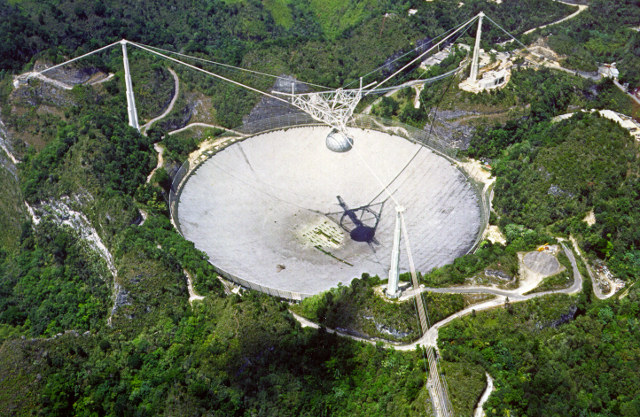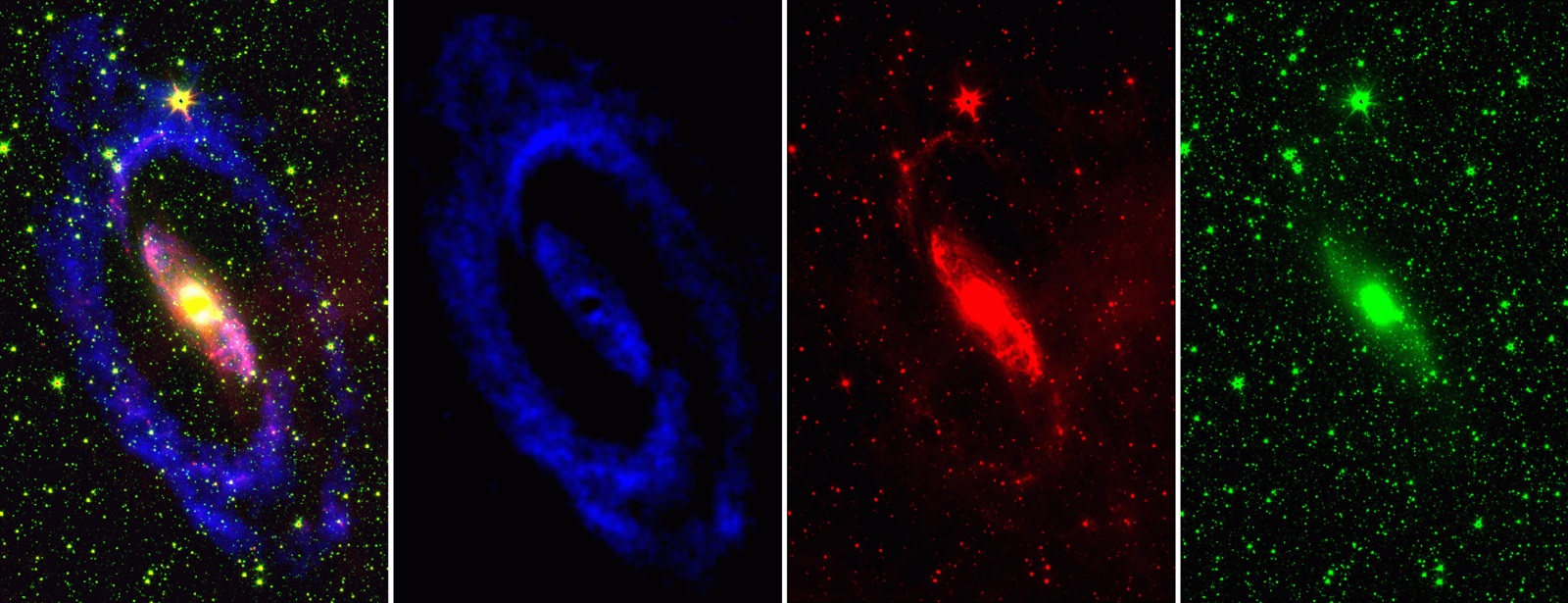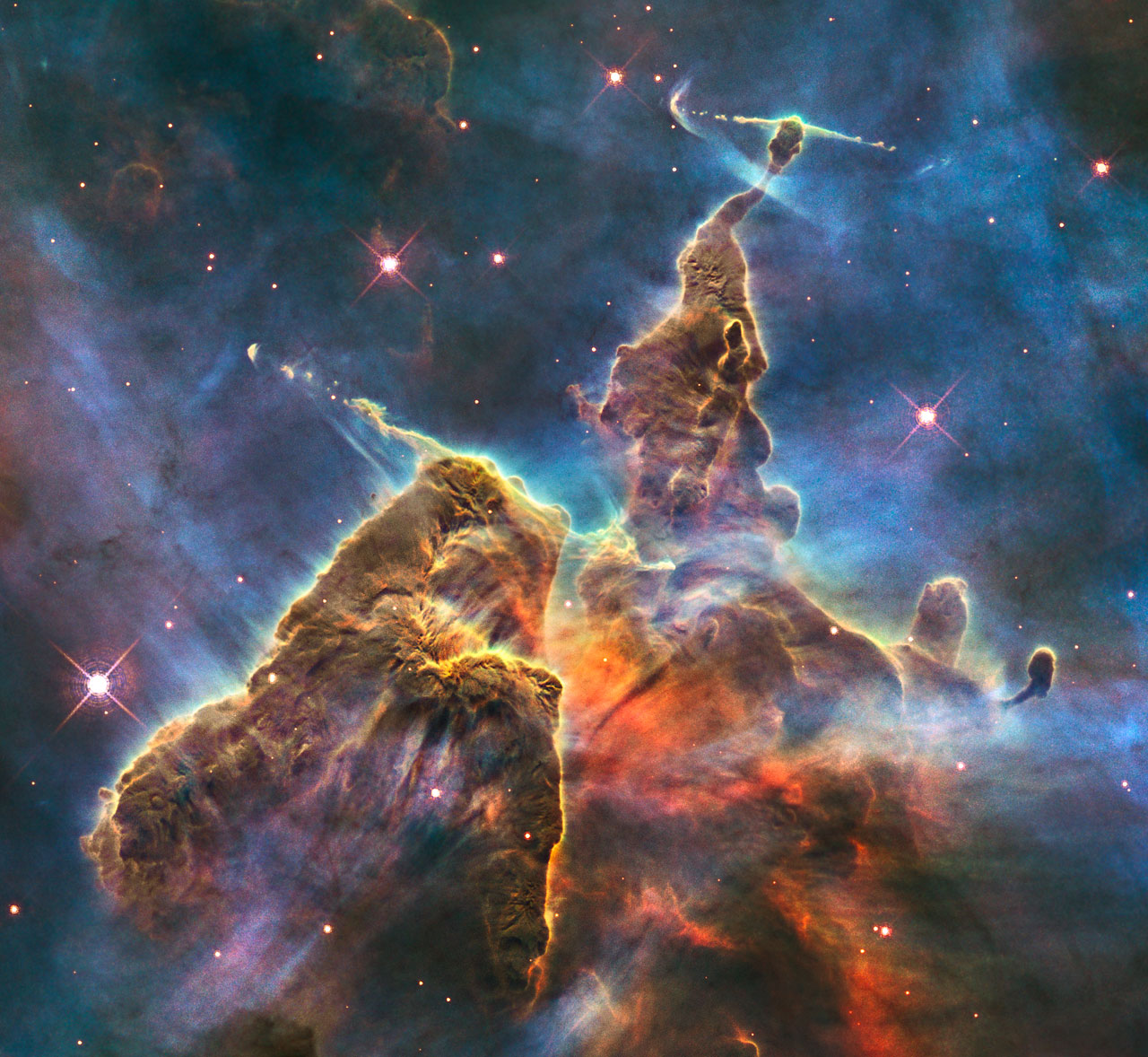
Whoa…what’s this thing?
It’s a radio telescope, the largest in the world. It’s so huge that a normal support system can’t support its weight. So it’s basically suspended between three mountaintops. It’s 300 m across, which is 1000 feet. It’s huge.
This is the kind of construction endeavor that radio astronomers must try if they want to get much detail from radio waves. The radio wavelengths of the electromagnetic spectrum are really, really weak. You need huge telescopes to collect enough.
But, as ever, astronomers face the same basic problem: money.
Huge telescopes are expensive. It’s unfortunate for astronomers, but true—just think of the cost of labor of basically burying a whole valley under a radio dish.
So why bother?
There are a number of reasons, and they’re good ones.

These images were taken using a radio telescope. We see cool hydrogen gas in blue, warm dust clouds in red, and actual stars in green. The image on the far left is a composite of all three.
Make no mistake—the image in green isn’t of visible light. It’s entirely possible these stars emit visible light, but the image is of the radio wavelengths of radiation they also emit.
I know it’s weird to think of stars and not radio stations emitting radio waves. We’ll talk about how stars do this later on. For now, just remember that radio waves came from stars first. Then radio stations figured it out and copied the technique.
Let’s first consider the clouds of cool hydrogen in the blue image.
Cool hydrogen is cool.
By that, I mean…literally cool. As in, not hot. Cool hydrogen is literally too cool to emit visible light.

This diagram of the electromagnetic spectrum tells us that as wavelength decreases, heading left from radio waves towards gamma rays, the radiation’s energy increases. In order to produce visible light, you need more energy than cool hydrogen has.
But cool hydrogen does produce radiation. Just about everything in the universe does. Can you guess what it emits, based on this diagram?
If you said radio waves, you’re right. Radio waves are cool enough—in fact, are the coolest form of electromagnetic radiation—that cool hydrogen can emit them.
Which means that we can only see it using radio telescopes.
Then, of course, there’s the case of dust clouds.
Space is full of them.

We can see dust clouds. They’re gorgeous. They’re incredible phenomena.
They’re where all the unused material for planets gets stored until solar systems start forming. Every bit of rock you’ve ever seen—and a lot that you haven’t seen, found deep within the Earth—came from one of these dust clouds.
Dust clouds emit no radiation of their own. They’re not just cool—they’re basically frozen. They’re in the cold vacuum of space, and they’re the material for planets, not stars—they don’t have nearly enough energy to start emitting radiation.
We can see them for the same reason you can see your desk, your walls, your house, your floor, your…well, anything that doesn’t emit light. Light reflects off of the objects in your life and reaches your eyes.
The same goes for dust clouds. So we can see them easily, just as long as there are stars to light them up. The problem is, we can’t see through them.
Why do we want to see through them? Because there’s bound to be stuff behind them, and we want to study it.
Most radiation can’t get through dust clouds. The only way for us to study the universe with current technology is to study the radiation that reaches Earth. So unless we can find some type of radiation that can get through a dust cloud, we’re screwed.
So…why can’t most radiation get through dust clouds?
It all comes down to wavelength.
This is something I’ve talked about at length before. Basically, any one form of radiation is different from another form only because of its wavelength. All radiation is literally shaped like waves.

Imagine that you’re really small—about the size of a single speck of dust. Yeah, that small.
Now imagine that you’re trying to get past that speck of dust.
You can’t change your direction, speed, or size. But here’s the good news: you can jump. And you always jump higher than the top of the speck of dust. The only problem is jumping far enough to get over it.
Whether you can do that depends on your wavelength—the distance between jumps.
(Seriously. Look at that wave above. Doesn’t it look like it’s bouncing up and down?)
Naturally, if you can jump farther, you stand a chance of getting past that dust particle. You need to vault all the way over it—if you touch it, you’ll bounce off of it and you’ll never reach Earth.
Only the longest wavelengths of light can jump that dust particle. And those longest wavelengths are radio waves.
See, radio waves are the key to “seeing” the universe beyond those pesky, beautiful, stubborn, incredible dust clouds. Without them, we’d be blind to much of the universe.
There’s one more reason to build radio telescopes, and it’s a lot closer to home.

By close to home, I mean…well…really close. Because this is an image of the surface of Venus.
This image would have been impossible without the help of radio waves.
Venus is a planet we’ll talk a lot about later on. (I say that a lot, don’t I? Well…I mean it.) It’s a curious planet. It’s Earth-like in many ways, except for its thick atmosphere.
And I mean…it’s a really thick atmosphere.
So thick that it’s basically like one of our pesky dust clouds. It’s a fascinating thing, that atmosphere, but it’s also in our way…of seeing the Venusian surface.
Thankfully, we’ve got radio waves. And thanks to radio waves, we’ve been able to map Venus’s entire surface. They’ve taught us a lot about our twin planet, and helped us realize that it’s really not as similar to us as we once thought.
And last but not least, radio waves are useful because some objects in the universe emit radio waves stronger than any form of radiation.
Cool hydrogen emits only radio waves. But there are some objects—like intensely hot gas orbiting black holes—that emits all wavelengths of radiation, but especially radio waves. Having radio telescopes makes it that much easier to study that material.
And…that’s it for radio astronomy. Next up, we’ll take a closer look at some other parts of the electromagnetic spectrum, besides visible light and radio waves…including infrared radiation, ultraviolet radiation, x-rays, and gamma rays.